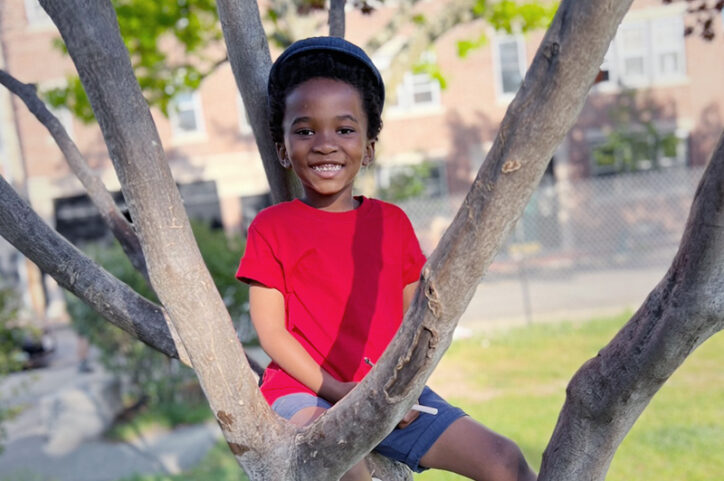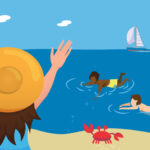Biko’s legacy: Mom honors her son through water safety awareness

Biko Mangcu was “a big bright light,” says his mother, Sipho. Everyone in his Cambridge, Massachusetts, neighborhood knew him. His big brown eyes and wide smile were featured in advertising that still adorns toy packaging. At school, his teachers and classmates called him “the mayor.”
“He was so full of love and joy,” says Sipho. “A really special kid.”
That’s how Sipho wants Biko to be remembered — not as a local “breaking news” headline. Still, she knows that Biko, who drowned last Memorial Day at age 4, has an important story to tell. “People don’t like hearing about sad situations like this — they don’t want to imagine that it can happen to their own child. But it can.”

‘It only takes a moment’
Sipho considered herself safety conscious when she and Biko arrived at their friends’ pool party that day. “There were six adults there, and we were actually talking about water safety and drowning — we knew it only takes a moment.” When some of the older kids started horsing around, one of the adults even chided them to be careful: “We don’t want to end up at Boston Children’s today.”
Yet within 20 minutes, Biko, who was still just learning to swim, had slipped into the pool unnoticed. Despite efforts at CPR and supportive care, he died that afternoon at Boston Children’s. About a week later, he was laid to rest on what would have been his fifth birthday.

Heartbreak and advocacy
For the past year, Sipho has struggled with the heartbreak of losing a child and the stigma that can surround drowning. “I worry I dropped the ball as a parent,” she says. Rationally, she knows that most families don’t have all the information they need to keep kids safe in and near the water. It’s a topic rarely raised at pediatrician offices and schools. Since Biko’s accident, she’s learned that drowning is now the leading cause of death in kids ages 1 to 4 and the second-leading cause of death in kids 5 to 14 — startling statistics that have inspired her to become a water-safety advocate.
Along with launching a viral social media campaign, Sipho is sharing her story — and tips for other families. “I don’t want another mom to go through this nightmare,” she says.
Ensure that your child can swim. For Biko’s older sister, swimming lessons were part of her school curriculum in their country of origin, South Africa. Although Biko had begun lessons in the U.S., they were delayed by the pandemic. Sipho has made it her mission to push for mandatory swim lessons in schools here: “The earlier they start, the better.”
Choose swimwear carefully. Biko’s favorite color was blue — so it was only natural that his swimsuit was blue, too. “We didn’t realize that would make him blend in with the water,” says Sipho. Opt for brightly colored suits that will stand out.
Pay close attention. It doesn’t matter how many adults are present at a pool or other body of water if they’re distracted. “If you think someone else is watching, they aren’t,” says Sipho. “It’s on you to look.” Assign a designated “water watcher” whose job is to do just that. If you can afford to, consider hiring a lifeguard for parties.
Don’t just listen — look. We tend to imagine drowning as obvious: shouting, screaming, and flailing. But drowning is often silent. “Biko was so close with me — he was always calling, ‘Mom this’ and ‘Mom that,’” says Sipho. “But he never called out for me that day. Drowning isn’t like what we see in the movies.”
A year after Biko’s accident, Sipho’s grief remains raw: “I refuse to sugarcoat it,” she says. “But I want to honor him by being a champion of change. Even in death, he’s still the Biko he was — making an impact on people’s lives.”
Read more water safety tips and check out our recent webinar on water safety.
Related Posts :
-

Diving into summer: What to know about water safety
The sun is back, the temperatures are rising, and that means more of us will be heading towards the water ...
-

Cannabis edibles: Keep kids safe from adult 'treats'
Candy and chips aren’t necessarily for kids anymore. These days, a chocolate bar, gummy, or bag of cheesy treats ...
-

Keep summer activities as safe as possible
As we move into a summer with COVID-19, many people are slowly venturing beyond their homes as businesses, beaches, and ...
-

Tiny, shiny, and dangerous: What families should know about button batteries
Button batteries may be bright, shiny, and eye catching, but they also have a dark side — especially for kids. Look ...





